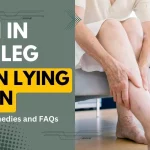Feeling pain in the heel when walking can make even short distances seem insurmountable. This type of foot pain, medically known as plantar fasciitis, affects an estimated 2 million Americans each year. The good news is that this common condition is very treatable with a combination of at-home care and medical interventions if needed. This article will explore the causes of and treatments for pain in heel of foot when walking, provide tips to find relief, and answer some frequently asked questions.
Causes of Pain in Heel of Foot When Walking
The plantar fascia is a thick band of connective tissue that runs across the bottom of the foot from the heel bone to the toes. Repeated pulling and straining of the plantar fascia can cause tiny tears and inflammation in the tissue, resulting in the characteristic stabbing pain with walking.
Some of the most common factors that contribute to plantar fasciitis include:
- Age – The risk increases after age 40 as the tissues of the foot become less flexible.
- Obesity – Excess weight places extra strain on the plantar fascia.
- Long Distance Running – Distance runners are especially prone as the impact stresses the foot.
- High Arches – Those with high arches are more likely to develop the condition.
- Tight Calf Muscles – Tight calf muscles cause additional pulling on the plantar fascia.
- Occupations that Require Lots of Standing – Jobs that involve long periods on the feet put strain on the plantar fascia.
- Flat Feet or High Arches – These foot types increase strain on the plantar fascia.
- Sudden Weight Gain – Abrupt increases in weight mean more stress on the feet.
- Repetitive Impact – Regular high-impact motions like step aerobics can irritate the plantar fascia over time.
So in summary, the primary factors that create small tears and cause heel pain are overuse, high impact exercise, increased weight, and foot structure/flexibility issues. Those at highest risk tend to be middle-aged, overweight, and have occupations that require long periods of standing or walking.
Treatment Options for Pain in Heel of Foot When Walking Relief
The good news is that there are many conservative treatment options to alleviate plantar fasciitis pain and help you get back on your feet again. Here are some of the most effective remedies:
- Rest – This allows the microtears in the plantar fascia to heal. Avoid activities that worsen pain.
- Ice – Icing the heel reduces inflammation. Apply ice wrapped in a thin towel for 15 minutes a few times per day.
- Over-the-counter pain medication – Anti-inflammatories like ibuprofen can relieve pain and reduce swelling.
- Stretching – Stretching the plantar fascia and calf muscles loosens tissues and prevents re-injury. Hold stretches for 30 seconds, 5x per day.
- Heel pads & orthotic inserts – These support the foot and reduce strain on the plantar fascia when standing or walking.
- Night splints – Worn at night, these keep the plantar fascia gently stretched to aid healing.
- Shoe modifications – Wear shoes with good arch support and cushioning. Avoid going barefoot.
- Physical therapy – Specific PT exercises will stretch and strengthen the feet and lower legs.
- Extracorporeal shockwave therapy – Use of sound waves applied to the heel induce inflammation and facilitate healing.
- Cortisone injections – Cortisone is a powerful anti-inflammatory medication injected directly into the plantar fascia tissue. Provides temporary relief.
- Surgery – Only used in very severe, chronic cases unresponsive to other treatments. Releases part of the plantar fascia to relieve tension and pain.
Home remedies like rest, ice, ibuprofen, and stretching should be tried first for 6-12 weeks. If you have not found relief with conservative measures, make an appointment with your doctor to explore medical options like orthotics, night splints, injections, or shockwave therapy. Consistent treatment will help manage symptoms long-term.
Tips for Finding Relief from Heel Pain
Making a few adjustments to your daily routine can really help minimize heel pain flare ups as you undergo treatment:
- Take rest breaks where you sit with feet elevated
- Avoid going barefoot and wear supportive, well-cushioned shoes
- Apply ice packs for 15 minutes after activity
- Do calf and foot stretches multiple times per day
- Roll a frozen water bottle under the arch after activity
- Limit activities that exacerbate pain like running or step aerobics
- Lose excess weight to reduce strain on feet
- Wear a night splint to gently stretch plantar fascia overnight
- Use inserts or orthotics in shoes to support the arch
- Consider a cane or crutches to temporarily limit weight on heels
With a period of modified rest and these simple measures, you can keep heel pain at bay and avoid re-injury as you heal. Be patient through the process and avoid pushing through pain. With time, the treatments will resolve inflammation and you’ll be back to walking normally.
In summary, classic symptoms of stabbing pain in heel of foot when walking can be caused by plantar fasciitis, an overuse injury affecting the foot’s connective tissue. Rest, ice, medication, stretching, orthotics, and physical therapy are simple, effective ways to find relief in most cases. Learn to avoid aggravating activities, do frequent foot stretches, and wear supportive shoes. With some modifications and consistency with treatment, you’ll soon be back to pain-free walking.
It’s important for you: Pain in the Groin and Down the Leg in Females
Frequently Asked Questions about Heel Pain
1. Is it safe to keep walking with heel pain?
Walking with heel pain is generally safe with some precautions. Take frequent breaks, ice the heel after activity, wear shoes with arch support, and limit walking distance to avoid re-injury. Severe or persistent pain may require a short period of rest.
2. Should I see a doctor for heel pain when walking?
Yes, see your doctor if home care strategies have not resolved pain after 6-12 weeks. Your doctor can identify any underlying medical issues and devise a treatment plan which may include physical therapy, orthotics, injections, or rarely, surgery.
3. Does plantar fasciitis go away on its own?
For about 90% of sufferers, the condition will resolve on its own within 10-12 months by resting and icing. But active treatment can speed healing and reduce recurrence. See a doctor if pain persists over a year.
4. Should I stop running if I have heel pain from plantar fasciitis?
Take a break from running while actively treating plantar fasciitis. Impact activities tend to aggravate it. Once pain resolves, ease back into running gradually. Wear shoes with good cushioning and consider orthotic inserts.
5. What exercises help relieve plantar fasciitis?
Calf and foot stretches are very beneficial, along with foot strengthening exercises using resistance bands. Physical therapy can provide a customized exercise program. Low-impact activities like swimming may also help.
6. Is a cortisone shot a good option for heel pain?
Cortisone injections can offer powerful anti-inflammatory effects and pain relief, but the results are temporary. They are not a standalone treatment, but used in conjunction with other methods. Multiple injections may weaken plantar fascia tissue.
7. What is the best shoe for plantar fasciitis?
Look for athletic shoes with excellent arch support, cushioning, and shock absorption. Shoes with a curved sole design are ideal to take stress off the heel. Replace shoes every 300-500 miles.
8. Can losing weight help relieve heel pain?
Yes, shedding excess pounds reduces strain on the plantar fascia and feet as a whole. A weight loss as small as 5-10 lbs can make a noticeable difference in plantar fasciitis pain.
9. Does plantar fasciitis eventually require surgery?
Only about 10% of patients require surgery if pain is severe and long-lasting. The procedure releases a portion of the plantar fascia to relieve tension. Non-surgical options are successful for 90% of sufferers.
10. What causes plantar fasciitis pain at night?
When the foot is at rest, the plantar fascia tightens and contracts. Night splints keep the tissue gently stretched to minimize morning pain after being immobile all night.



